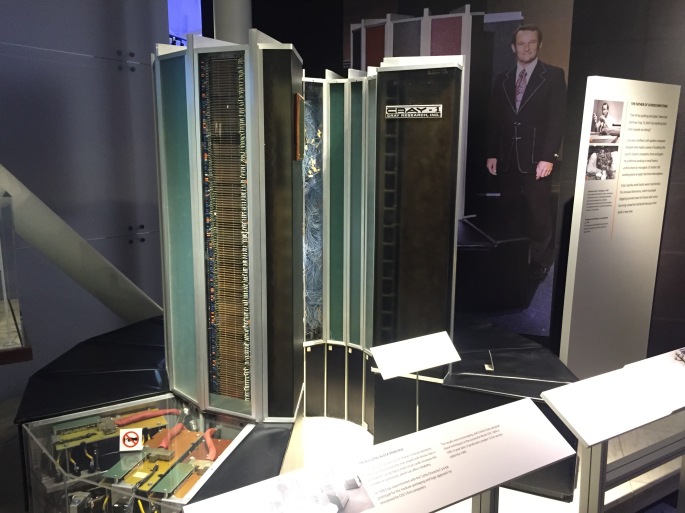A little different than my usual outdoor adventure blog post, but it’s fascinating to ***me*** and it’s ***my*** blog, so there! If you’re a techie who likes history, or an aging techie who isn’t sure if seeing familiar old hardware preserved under glass is a good thing, then read on…
Right at the SE corner of Highway 101 and Shoreline Blvd, in the heart of Silicon Valley, is the “Computer History Museum” http://www.computerhistory.org/ (Ironically, it’s located in a former Sun Microsystems or Silicon Graphics building, which is a bit of “history” itself!)

Once you pay your fee to enter, look to your left before you enter the main exhibit area. You’ll see the “PDP-1 Lab” and the “IBM 1401” Lab. Both were very “significant computing platforms” in their day, and may bring back memories of “real computers” if you’re old enough: round CRT screens, tape drives, noisy printers, punch card readers…
Here is the PDP-1 lab, circa 1959. Note the round CRT screen and the “electric typewriter” style printer:
Next door is the IBM 1401 room. This is what an Old School mainframe is to me, including the raised floor for wiring and cooling.

Moving on to the main exhibits, you’ll start with antique computing devices. (Not to be confused with “computers”, which was originally a term coined in the 1940’s for the women (predominantly) who operated the computing machinery of the day!)
Some older “stuff”, including mid- to late-1970’s HP and TI calculators with newfangled LED displays, including the classic HP-41.
Below is a piece of the ENIAC (Electronic Numeric Integrator and Calculator), designed to calculate ballistics tables for the Army (trajectories and targeting tables for various munitions and operating conditions)
Ah yes! What “classic” computer doesn’t have a tape drive, with a Jetsons-era name on it like “Univac”?
…and for those knowledgeable about WW2. here is a real “game changer” Norden Bomb Sight, suspended inside a simulated nose of an American WW2 bomber.
The world’s first “disk drive”, the “Ramac 350”. It’s about the size of a washing machine and could store the equivalent of 62,000 punch cards (5 million characters!)
…and below is 128K bits of LSI Bipolar memory from Fairchild, conveniently packaged in a metal can a little bigger than a loaf of bread. (My iPhone stores over a million times as much information…much of it useless!!)
..and a Cray-1. Note the racks are in a circular pattern so that the longest wire is less than 3 feet. This was key to making the Cray the fastest in the world by reducing signalling delays in the wires. (I have nothing to say about the white trim on Seymour Cray’s suit)
Below is a tribute to the old Wagon Wheel Bar in Mountain View. where many historical conversations and business plans were drawn-up. It was torn-down in the early-90’s.
ROBOTS! Is that Rosie, from the Jetsons?
Here’s “PONG!”, the first coin-operated video game. Designed and assembled in Silicon Valley in 1972 by Atari. It was paired with an off-the-shelf TV and placed in a cabinet. It was a huge hit at Andy Capp’s Tavern in Sunnyvale, where the first one was placed. (That building is now “Rooster T. Feathers”, on El Camino Real)
Here’s a VERY valuable Apple 1, with Woz’s autograph in the center of the upper wood cabinet.
Now, here we get to my own first computer, the Commodore VIC-20 (top-left). Wow, was that cassette tape drive a frustrating device! They also have MITS Altair, Atari, Sinclair, Radio Shack, and many other early computers that were marketed directly to home users
That’s it! Next time you’re in Mountain View take a look! (Do you wonder how Facebook, Twitter and Microsoft will be represented in museums a few decades down the road? Hardware is entirely different…)
























Thank you for the article. This article gives us good knowledge.